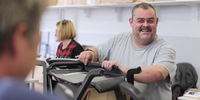
Background information
The birth of a sledge like no other
by Michael Restin

Yves Aeschbacher is an industrial designer and sledge tinkerer. He has been working for years on a further development of the classic Davos sledge. A conversation about sandwich wood, hammocks and sexy runners.
The design? Comes from Yves. The production sites? Yves chose them. The processes? Yves developed them. When I visit the production of the "Black Hawk" sports sled at the Wendepunkt foundation, it quickly becomes clear that one person is missing: Yves. "It's best to give him a call," says Alex Maienfisch from Mach. The sled is sold under the umbrella of his ski brand, but neither he nor production manager Alex Truninger want to adorn themselves with other people's feathers.
With Yves' feathers. The 30-year-old industrial designer is the mastermind behind the product and has put a lot of work into its development. The result is a local, social and uncompromising reinterpretation of the classic Davos Yves Aeschbacher tells me more about it on the phone.

How did you come up with the idea of developing a sled?
Yves Aeschbacher, industrial designer: I studied industrial design in Basel. In one module, we set ourselves the goal of redesigning a piece of sports equipment that hadn't undergone much development work in recent decades and still had potential. That's when we came up with the sled.
A few years have passed since then. You carried on and built various prototypes before the "Black Hawk" finally came onto the market. What makes it different from the classic wooden sled?Firstly, the material. I use moulded beech wood. Many sandwich skis are constructed in this way and this craft has been around for decades. I wondered why it is no longer used. Most sledges are steam bent. After a certain point, you can no longer bend a radius. Layer gluing gives you more creative freedom.
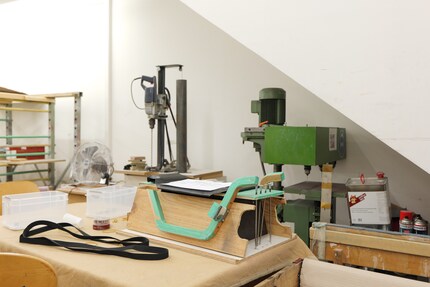
What did you want to use it for?
The sitting position on the toboggan or Davos sled bothered me a bit. You lie with your upper body at the back and work with weight shifting, the drawstring and your feet. The idea with my sled was that you can sit more upright and steer more intuitively. I solved it so that you steer via the sled frame. You can hold on to it and work with it, because it is movable.
You need to explain the construction in more detail.
I thought about how to make the seat ergonomic and comfortable. The curved wooden frame makes it possible to create a lightweight cantilever chair, the seat is just clamped in. You sit almost a bit like in a hammock. It was really very difficult to design this to be free-floating. With the first prototypes, almost every seat tore.
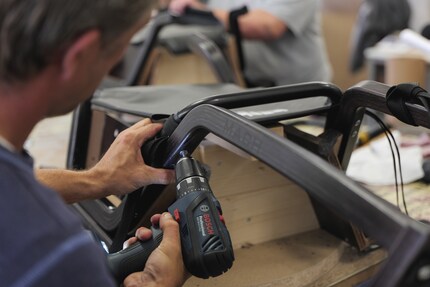
How did you solve this problem?
The old seat was sewn. The new one is thermo-welded, double-layered and padded. It's an all-in-one solution that required a lot of experience. It is now a high-end seat that I have developed over the years with the Murghof workshops in Frauenfeld. We were also able to take a step forward in terms of manoeuvrability. We now have one less fixed screw connection. A bracket holds the entire construction in place, making the sled more manoeuvrable and agile.
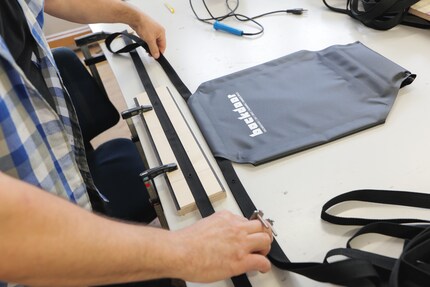
I've heard that controlling the frame takes a bit of getting used to at first.
That's true. But then it's more pleasant, quieter and more comfortable. If you hold on to the pull cord on a classic sled, your upper body is more or less free in the air. After a bump or if you enter a bend too quickly, it is difficult to keep your balance. Perhaps some of you know the feeling of arriving at the bottom with extremely tight abdominal muscles and not always having been in control. I now have my sled so well under control that I can ride almost hands-free. Very cosy. But that takes a bit of experience.
The sledge has been in use at various hire stations since last year, for example in Gstaad and Adelboden. How was the feedback after the first season?
There were no special feedback forms. But if people don't complain, they are generally satisfied. The mountain railways told us that it is very comfortable to ride. It is also easy to stack and takes up little space. It is also very fast with the plastic runners, especially on flat sections.
The runners are more like ski bases. Are they also that sensitive?
In the private sector, you might have to buy a new one after five or six years. You actually always ski on the inside edge because it is at a 20-degree angle to the snow. The plastic runner can be turned and used twice. It's also quick to replace and not very expensive. We have a dovetail connection and practically no resistance when pushing it on. I think that's a sexy solution (laughs).
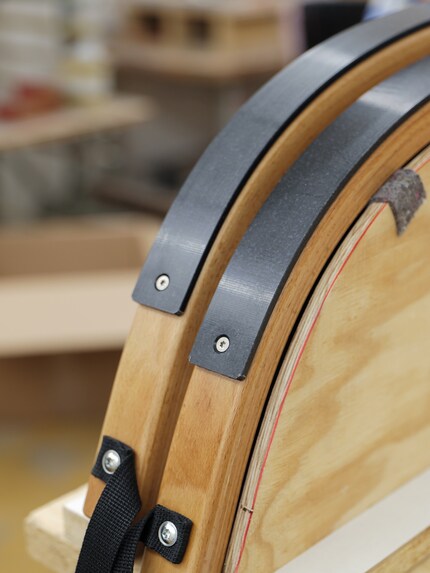
So far, the "Black Hawk" is only available as a single-seater. Would a two-seater be possible?
Yes, but safety must take centre stage. That's why we have a single-seater. There are simply too many accidents. Day tourists often don't know the sledging technique properly, but hire something and just go for a ride. I see so many sledgers without gloves and helmets in trainers. Sledging is also a sport, it can be fast and dangerous. You should be at least as well equipped as when skiing. Our sledge looks more technical and sporty. Perhaps some of you will also remember to protect yourself accordingly.
Are there any further developments planned?
I'm thinking about making a junior version for children. But that's not a topic at the moment. We don't want to rush it. There are still gadgets on the "Black Hawk" that we can work on. For example, racing skids or lighting. There are a lot of people who go night sledging. Only when we have exhausted the potential will we go one step further.
Yves has travelled a long way to reach the "Black Hawk" in its current form in many small development steps. At the end of our conversation, he had one more question for me: "My goal as an industrial designer was a modern design. Something that stands out and yet doesn't look too futuristic. The sledge is still made of wood and has a classic curve. At the same time, I wanted it to be a modern piece. I ask you: have I achieved that?" In my opinion, the design is very successful. What do you think?
Did Yves achieve his design goal?
The competition has ended.
If you need more than one click for your answer or if you have any further questions, just write them in the comments column.
Simple writer and dad of two who likes to be on the move, wading through everyday family life. Juggling several balls, I'll occasionally drop one. It could be a ball, or a remark. Or both.
Interesting facts about products, behind-the-scenes looks at manufacturers and deep-dives on interesting people.
Show all